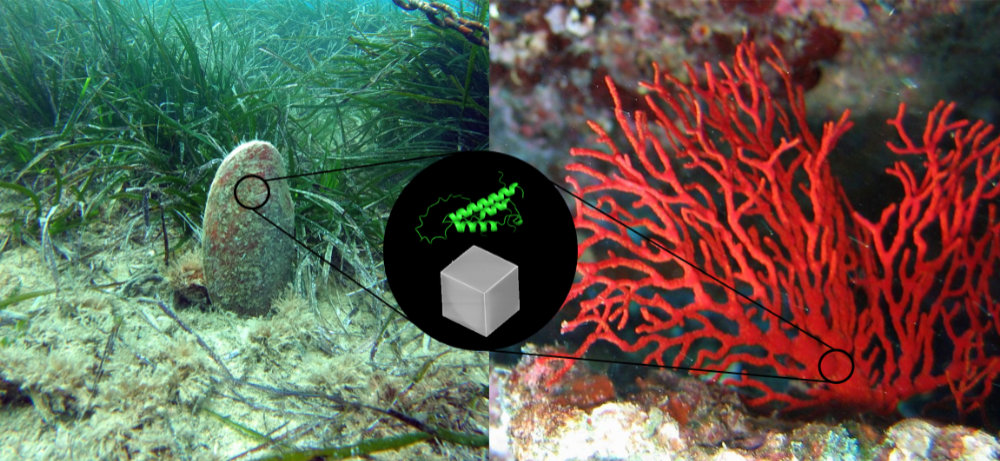Benazir Khurshid PhD thesis
 Organic/inorganic interface in biominerals: unveiling the complex structure of two calcitic biomineral models, the red coral Corallium rubrum and the fan mussel Pinna nobilis
Organic/inorganic interface in biominerals: unveiling the complex structure of two calcitic biomineral models, the red coral Corallium rubrum and the fan mussel Pinna nobilis
Funding: ANR MOBi
Started in october 2019
Supervisor: Frédéric Marin ; cosupervisor: Jonathan Perrin (Synchrotron SOLEIL)
Defended the 16 december 2022
Abstract
Biominerals are organo-minerals structures produced by living systems. Since the Cambrian, they contribute to the adaptation of living organisms to different environments by fulfilling a variety of combined functions that go along with adapted morphologies. One of the aims of biomineralization is to understand how organisms “sculpt” these complex morphologies, at nano and molecular scales. The aim of this PhD work was to understand the complex relationships between the organic and mineral phases. To this end, I studied two calcitic biomineral models: 1) the red coral Corallium rubrum and 2) the prismatic shell of the Mediterranean fan mussel Pinna nobilis. My work deals with two different – but complementary – approaches to understand the complex mechanism of biomineralization: one is based on physio-chemical characterization, the other, on biochemical and proteomic analysis of the organics contained in the biomineral.
For physio-chemical characterization, I have used three different imaging techniques available at Synchrotron-SOLEIL: X-ray microtomography, Deep-UV luminescence imaging and at last, secondary harmonic generation (SHG) microscopy for analyzing the red coral. These combined high-resolution techniques illustrate different facets of the structural complexity of this model. In parallel, the organic matrix contained in the calcitic prismatic shell layer of the fan mussel Pinna nobilis was biochemically characterized. In addition, the whole set of prism-associated proteins was obtained by proteomics. Furthermore, I analyzed more specifically one 11KDa protein named accripin11, to understand its role in the prism formation process. Finally, I developed a novel technique in biomineralization – based on AFM imaging with antibody-functionalized tips – that allowed localizing accripin11 on the surface of the shell prisms with a nanometric resolution. In summary, my work contributes to the advancement of imaging tools to observe biominerals and to better understand the distribution of organics in these complex structures. It represents one of the few attempts to bridge the gap between biology and physics in biomineralization studies.
Keywords
biomineralization, calcite, Pinna nobilis, Corallium rubrum, AFM, proteomics, skeletal matrix
Jury
Ingrid M. WEISS, Université de Stuttgart, Allemagne – reviewer
Joël GAUTRON, INRAE, Nouzilly – reviewer
Sylvie TAMBUTTE, Centre Scientifique de Monaco – examiner
Antonio CHECA, Université de Grenade, Espagne – examiner
Daniel VIELZEUF, CINaM, Université d’Aix-Marseille – examiner
Jonathan PERRIN, Scientifique, Synchrotron SOLEIL, Saint-Aubin – cosupervisor
Frédéric MARIN, Biogéosciences, Université de Bourgogne-Franche-Comté – supervisor
- extrait:
- lien_externe:
- titre:
- Interfaces organo-minéraux dans les biominéraux
- date_de_debut_these:
- octobre 2019
- nom:
- Khurshid
- date_de_debut_these_numerique:
- 201910
- kc_data:
- a:8:{i:0;s:0:"";s:4:"mode";s:0:"";s:3:"css";s:0:"";s:9:"max_width";s:0:"";s:7:"classes";s:0:"";s:9:"thumbnail";s:0:"";s:9:"collapsed";s:0:"";s:9:"optimized";s:0:"";}
- kc_raw_content:
 Organic/inorganic interface in biominerals: unveiling the complex structure of two calcitic biomineral models, the red coral Corallium rubrum and the fan mussel Pinna nobilis
Organic/inorganic interface in biominerals: unveiling the complex structure of two calcitic biomineral models, the red coral Corallium rubrum and the fan mussel Pinna nobilisFunding: ANR MOBi
Started in october 2019
Supervisor: Frédéric Marin ; cosupervisor: Jonathan Perrin (Synchrotron SOLEIL)
Defended the 16 december 2022
Abstract
Biominerals are organo-minerals structures produced by living systems. Since the Cambrian, they contribute to the adaptation of living organisms to different environments by fulfilling a variety of combined functions that go along with adapted morphologies. One of the aims of biomineralization is to understand how organisms "sculpt" these complex morphologies, at nano and molecular scales. The aim of this PhD work was to understand the complex relationships between the organic and mineral phases. To this end, I studied two calcitic biomineral models: 1) the red coral Corallium rubrum and 2) the prismatic shell of the Mediterranean fan mussel Pinna nobilis. My work deals with two different - but complementary - approaches to understand the complex mechanism of biomineralization: one is based on physio-chemical characterization, the other, on biochemical and proteomic analysis of the organics contained in the biomineral.
For physio-chemical characterization, I have used three different imaging techniques available at Synchrotron-SOLEIL: X-ray microtomography, Deep-UV luminescence imaging and at last, secondary harmonic generation (SHG) microscopy for analyzing the red coral. These combined high-resolution techniques illustrate different facets of the structural complexity of this model. In parallel, the organic matrix contained in the calcitic prismatic shell layer of the fan mussel Pinna nobilis was biochemically characterized. In addition, the whole set of prism-associated proteins was obtained by proteomics. Furthermore, I analyzed more specifically one 11KDa protein named accripin11, to understand its role in the prism formation process. Finally, I developed a novel technique in biomineralization - based on AFM imaging with antibody-functionalized tips - that allowed localizing accripin11 on the surface of the shell prisms with a nanometric resolution. In summary, my work contributes to the advancement of imaging tools to observe biominerals and to better understand the distribution of organics in these complex structures. It represents one of the few attempts to bridge the gap between biology and physics in biomineralization studies.
Keywords
biomineralization, calcite, Pinna nobilis, Corallium rubrum, AFM, proteomics, skeletal matrix
Jury
Ingrid M. WEISS, Université de Stuttgart, Allemagne - reviewer
Joël GAUTRON, INRAE, Nouzilly - reviewer
Sylvie TAMBUTTE, Centre Scientifique de Monaco - examiner
Antonio CHECA, Université de Grenade, Espagne - examiner
Daniel VIELZEUF, CINaM, Université d'Aix-Marseille - examiner
Jonathan PERRIN, Scientifique, Synchrotron SOLEIL, Saint-Aubin - cosupervisor
Frédéric MARIN, Biogéosciences, Université de Bourgogne-Franche-Comté - supervisor
